Influence and Mechanism Study of Ultrasonic Electric Power Input on Heavy Oil Viscosity
Abstract
1. Introduction
2. Materials and Methods
2.1. Experimental Samples and Instruments
2.1.1. Experimental Samples
2.1.2. Experimental Instruments
2.2. Experimental Samples and Instruments
2.2.1. Preparing of Heavy Oil
2.2.2. Ultrasonic Irradiation
2.2.3. Measurement of Acoustic Cavitation Noise
2.2.4. Measure of Viscosity and Chemical Analysis
3. Results and Discussions
3.1. Viscosity Variation Conditions
3.1.1. US Irradiation 6 min
3.1.2. US Irradiation 12 min
3.2. Results of Chemical Analysis
3.2.1. US Irradiation 6 min
- FTIR results
- 2.
- GC results
3.2.2. US Irradiation 12 min
- 3.
- FTIR results
- 4.
- GC results
3.3. Cavitation Noise Analysis
3.4. Discussion
4. Conclusions and Prospect
Author Contributions
Funding
Data Availability Statement
Acknowledgments
Conflicts of Interest
Abbreviations
| US | Ultrasonic |
| FTIR | Fourier Transform Infrared Spectrometer |
| GC | Gas Chromatography |
| VRR | Viscosity reduction rate |
References
- Shishkova, I.; Stratiev, D.; Kolev, I.V.; Nenov, S.; Nedanovski, D.; Atanassov, K.; Ivanov, V.; Ribagin, S. Challenges in petroleum characterization—A review. Energies 2022, 15, 7765. [Google Scholar] [CrossRef]
- Li, X.J. Classification and evaluation methods of heavy crude oil resources at home and abroad. Inn. Mong. Petro Chem. Ind. 2008, 34, 61–62. [Google Scholar]
- Stratiev, D.; Nenov, S.; Nedanovski, D.; Shishkova, I.; Dinkov, R.; Stratiev, D.D.; Stratiev, D.D.; Sotirov, S.; Sotirova, E.; Atanassova, V.; et al. Empirical modeling of viscosities and softening points of straight-run vacuum residues from different origins and of hydrocracked unconverted vacuum residues obtained in different conversions. Energies 2022, 15, 1755. [Google Scholar] [CrossRef]
- Stratiev, D.; Shishkova, I.; Dinkov, R.; Nenov, S.; Sotirov, S.; Sotirova, E.; Kolev, I.; Ivanov, V.; Ribagin, S.; Atanassov, K.; et al. Prediction of petroleum viscosity from molecular weight and density. Fuel 2023, 331, 125679. [Google Scholar] [CrossRef]
- Guo, K.; Li, H.; Yu, Z. In-situ heavy and extra-heavy oil recovery: A review. Fuel 2016, 185, 886–902. [Google Scholar] [CrossRef]
- Chen, X.F.; Xu, Z.C.; Gong, Q.T.; Wu, D.H.; Zhang, L.; Zhang, L.; Zhao, S. Adsorption of extended anionic surfactants at the water-polymethylmethacrylate interface: The effect of polyoxyethylene groups. Colloids Surf. A Physicochem. Eng. Asp. 2022, 656, 130395. [Google Scholar] [CrossRef]
- Li, C.X. Cude Oil Rheology; China University of Petroleum Press: Beijing, China, 2006. [Google Scholar]
- Sawarkar, A.N. Cavitation induced upgrading of heavy oil and bottom-of-the-barrel: A review. Ultrason. Sonochem. 2019, 58, 104690. [Google Scholar] [CrossRef]
- Rehman, M.M.; Meribout, M. Conventional versus electrical enhanced oil recovery: A review. J. Petrol. Explor. Prod. Technol. 2012, 2, 169–179. [Google Scholar] [CrossRef]
- Kadyirov, A.; Karaeva, J. Ultrasonic and heat treatment of crude oils. Energies 2019, 12, 3084. [Google Scholar] [CrossRef]
- Avvaru, B.; Venkateswaran, N.; Uppara, P.; Iyengar, S.B.; Katti, S.S. Current knowledge and potential applications of cavitation technologies for the petroleum industry. Ultrason. Sonochem. 2018, 42, 493–507. [Google Scholar] [CrossRef]
- Sokolov, A.V.; Simkin, E.M. Study of Influence of Acoustic Treatment on Rheological Properties of Some Oils; All-Union Research Institute of Nuclear Geophysics and Geochemistry: Moscow, Russia, 1981; pp. 137–142. [Google Scholar]
- An, X.H.; Zhang, Y.P. The experimental results of reducing viscosity of heavy crude oil by ultrasonic wave. Oil Gasfield Surf. Eng. 1996, 5, 20–21. [Google Scholar]
- Bjorndalen, N.; Islam, M.R. The effect of microwave and ultrasonic irradiation on crude oil during production with a horizontal well. J. Pet. Sci. Eng. 2004, 43, 139–150. [Google Scholar] [CrossRef]
- Shedid, S.A. An ultrasonic irradiation technique for treatment of asphaltene deposition. J. Pet. Sci. Eng. 2004, 42, 57–70. [Google Scholar] [CrossRef]
- Mousavi, S.M.; Ramazani, A.; Najafi, I. Effect of ultrasonic irradiation on rheological properties of asphaltenic crude oils. Pet. Sci. 2012, 9, 82–88. [Google Scholar] [CrossRef]
- Mullakaev, M.S.; Volkova, G.I.; Gradov, O.M. Effect of ultrasound on the viscosity-temperature properties of crude oils of various compositions. Theor. Found. Chem. Eng. 2015, 49, 287–296. [Google Scholar] [CrossRef]
- Shi, C.W.; Yang, W.; Chen, J. Application and mechanism of ultrasonic static mixer in heavy oil viscosity reduction. Ultrason. Sonochemistry 2017, 37, 648–653. [Google Scholar] [CrossRef]
- Huang, X.T.; Zhou, C.H.; Suo, Q.Y.; Wang, S.H. Experimental study on viscosity reduction for residual oil by ultrasonic. Ultrason. Sonochem. 2018, 41, 661–669. [Google Scholar] [CrossRef]
- Gao, J.B.; Xu, D.L.; Wang, X.M.; Zhu, C.H. Orthogonal experiments of the heavy oil viscosity reduction by using ultrasonic wave. Petrochem. Technol. 2021, 50, 313–318. [Google Scholar]
- Hamidi, H.; Mohammadian, E.; Junin, R.; Rafati, R.; Manan, M.; Azdarpour, A.; Junid, M. A technique for evaluating the oil/heavy-oil viscosity changes under ultrasound in a simulated porous medium. Ultrasonics 2014, 54, 655–662. [Google Scholar] [CrossRef]
- Jaber, T.S.; Ali, S.; Hassan, N. The experimental investigation of effect of microwave and ultrasonic waves on the key characteristics of heavy crude oil. J. Anal. Appl. Pyrolysis 2017, 128, 92–101. [Google Scholar]
- Jaber, T.S.; Ali, S.; Hassan, N. Analysis of the asphaltene properties of heavy crude oil under ultrasonic and microwave irradiation. J. Anal. Appl. Pyrolysis 2018, 129, 171–180. [Google Scholar]
- Cui, J.J.; Zhang, Z.H.; Liu, X.D.; Liu, L.; Peng, J. Studies on viscosity reduction and structural change of crude oil treated with acoustic cavitation. Fuel 2020, 263, 116638. [Google Scholar] [CrossRef]
- Cui, J.J.; Zhang, Z.H.; Liu, X.D.; Liu, L.; Peng, J. Analysis of the viscosity reduction of crude oil with nano-Ni catalyst by acoustic cavitation. Fuel 2020, 275, 117976. [Google Scholar] [CrossRef]
- Liu, J.; Yang, F.K.; Xia, J.Y.; Wu, F.P.; Pu, C.S. Mechanism of ultrasonic physical-chemical viscosity reduction for different heavy oils. ACS Omega 2021, 6, 2276–2283. [Google Scholar] [CrossRef]
- Gao, J.B.; Li, C.; Xu, D.L.; Wu, P.F.; Lin, W.J.; Wang, X.M. The mechanism of ultrasonic irradiation effect on viscosity variations of heavy crude oil. Ultrason. Sonochem. 2021, 81, 105842. [Google Scholar] [CrossRef] [PubMed]
- Feng, R. Ultrasonic Manual; Nanjing University Press: Nanjing, China, 1999. [Google Scholar]
- Wu, P.F.; Wang, X.M.; Lin, W.J.; Bai, L.X. Acoustic characterization of cavitation intensity: A review. Ultrason. Sonochem. 2022, 82, 105878. [Google Scholar] [CrossRef]
- Lauterborn, W.; Cramer, E. Subharmonic route to chaos observed in acoustics. Phys. Rev. Lett. 1981, 47, 1445. [Google Scholar] [CrossRef]
- Wu, P.F.; Bai, L.X.; Lin, W.J.; Wang, X.M. Mechanism and dynamics of hydrodynamic-acoustic cavitation. Ultrason. Sonochem. 2018, 49, 89–96. [Google Scholar] [CrossRef]
- Weng, S.F.; Xu, Y.Z. Fourier Transform Infrared Spectroscopy, 3rd ed.; Chemical Industry Press: Beijing, China, 2016. [Google Scholar]
- Hua, Q. Experimental studies on viscosity reduction of heavy crude oil by ultrasonic irradiation. Acoust. Phys. 2020, 66, 495–500. [Google Scholar]
- Lv, S.H.; Peng, S.; Zhang, R.J.; Guo, Z.; Du, W.C.; Zhang, J.; Chen, G. Viscosity reduction of heavy oil by ultrasonic. Petrol. Chem. 2020, 60, 998–1002. [Google Scholar]
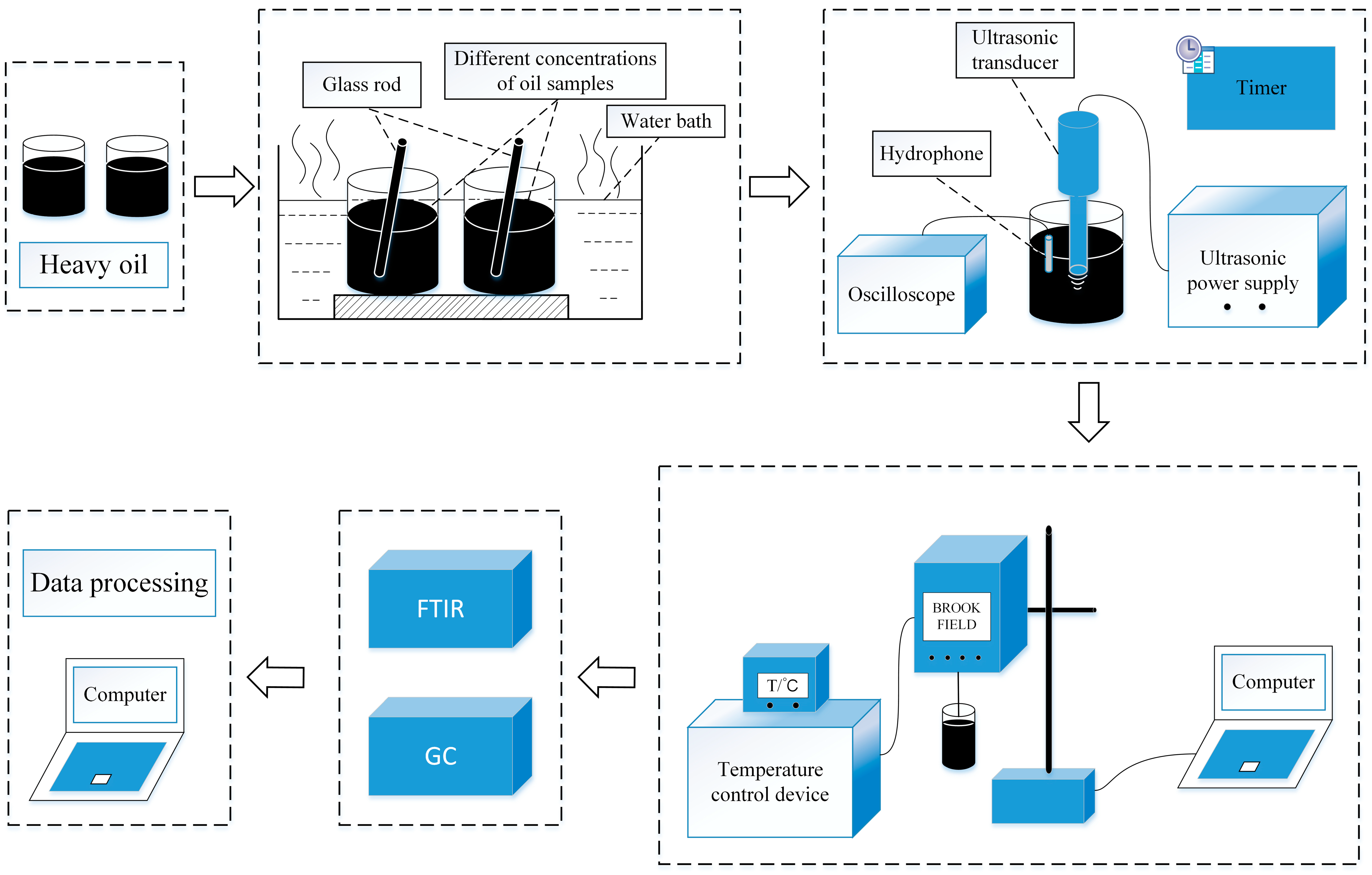

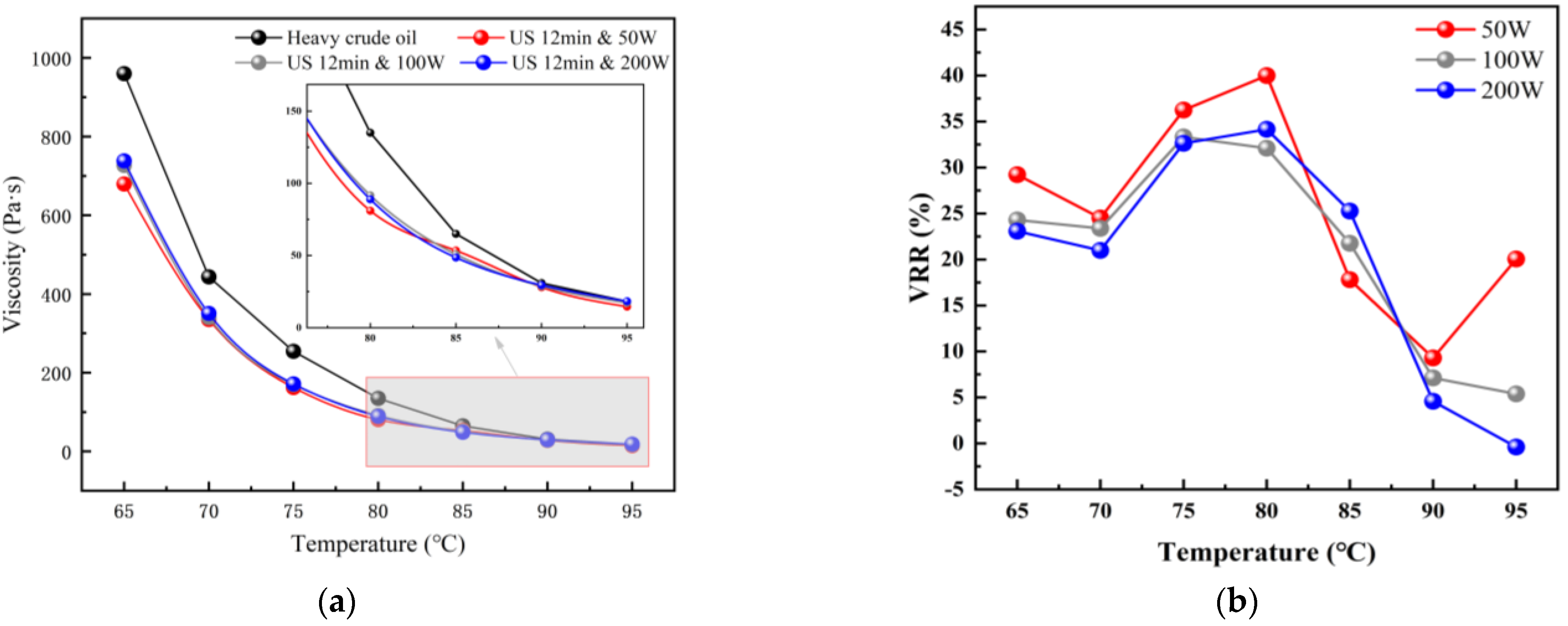


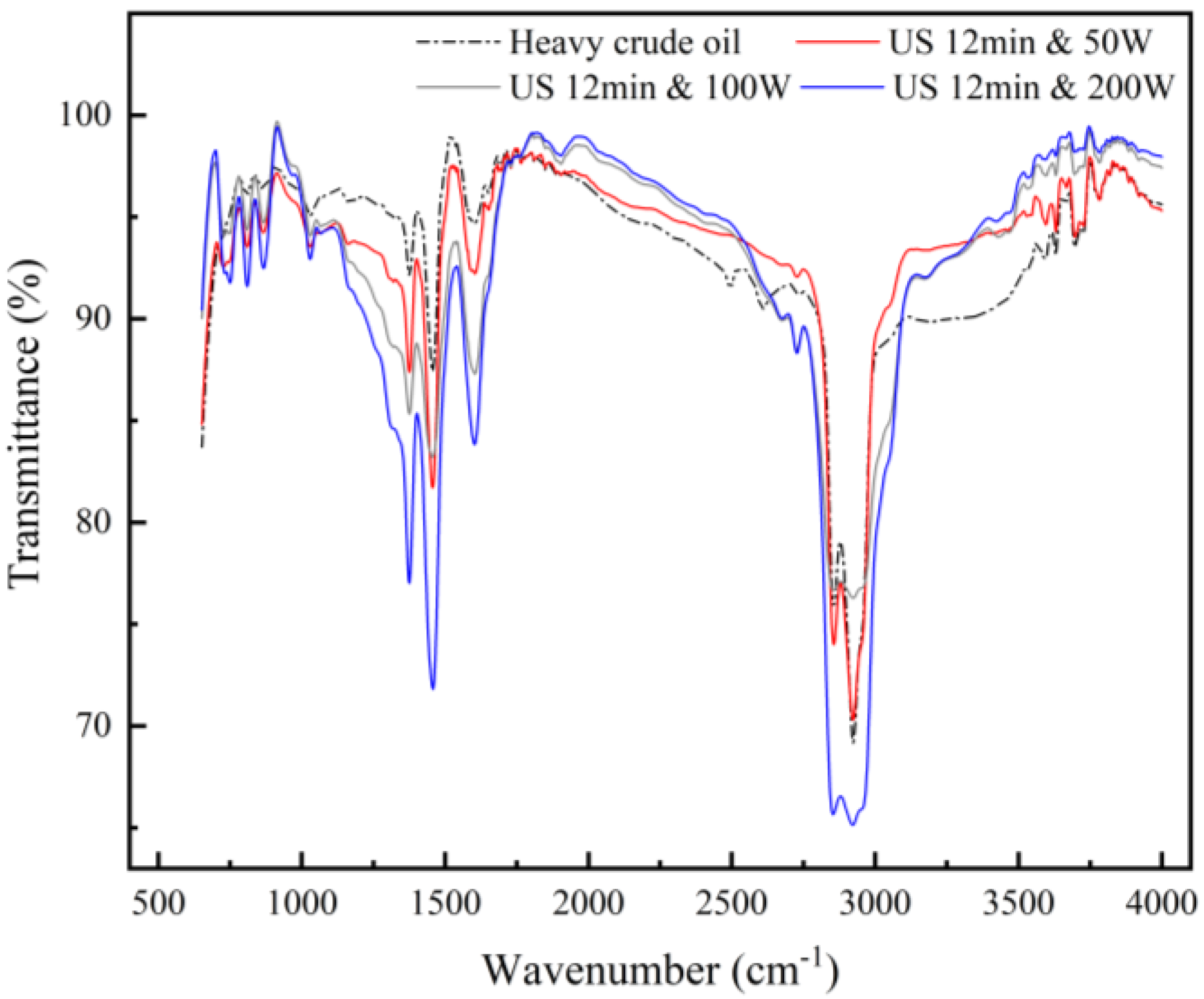

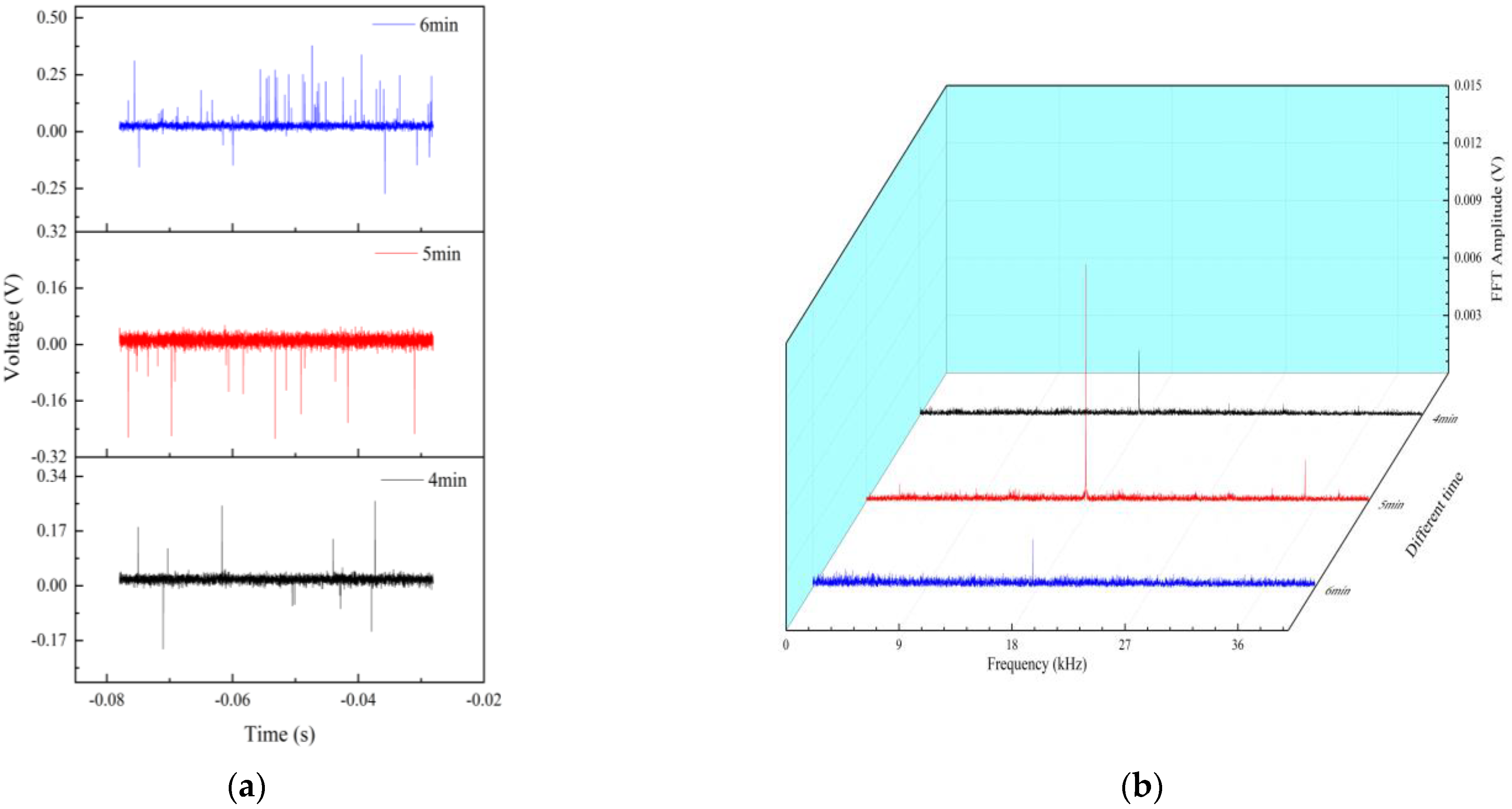
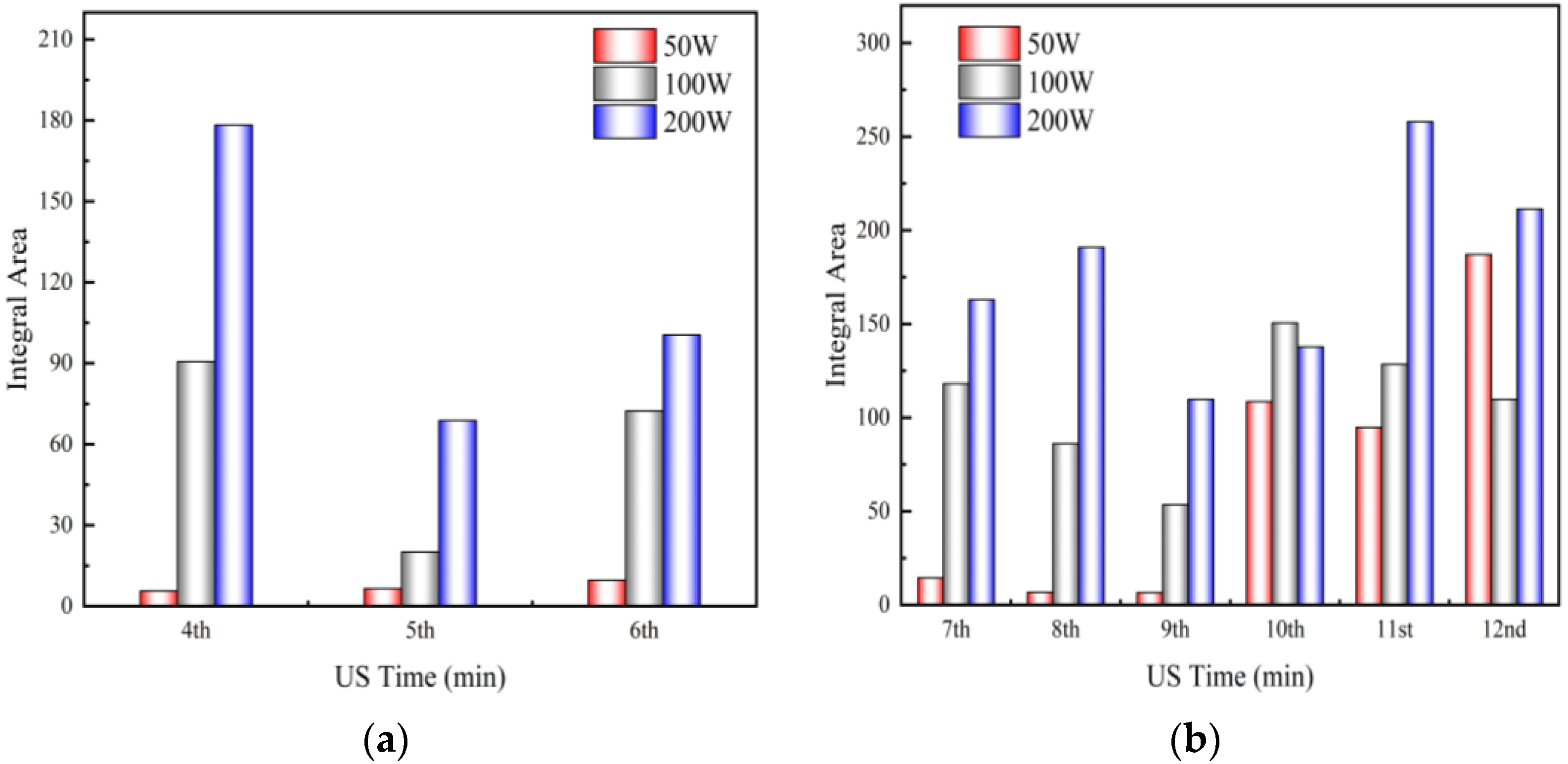
| Temperature/°C | 65 | 70 | 75 | 80 | 85 | 90 | 95 |
| Viscosity/Pa·s | 960.000 | 443.750 | 254.444 | 135.000 | 65.000 | 30.917 | 18.263 |
Disclaimer/Publisher’s Note: The statements, opinions and data contained in all publications are solely those of the individual author(s) and contributor(s) and not of MDPI and/or the editor(s). MDPI and/or the editor(s) disclaim responsibility for any injury to people or property resulting from any ideas, methods, instructions or products referred to in the content. |
© 2022 by the authors. Licensee MDPI, Basel, Switzerland. This article is an open access article distributed under the terms and conditions of the Creative Commons Attribution (CC BY) license (https://creativecommons.org/licenses/by/4.0/).
Share and Cite
Gao, J.; Wu, P.; Li, C.; Xu, D.; Wang, X. Influence and Mechanism Study of Ultrasonic Electric Power Input on Heavy Oil Viscosity. Energies 2023, 16, 79. https://doi.org/10.3390/en16010079
Gao J, Wu P, Li C, Xu D, Wang X. Influence and Mechanism Study of Ultrasonic Electric Power Input on Heavy Oil Viscosity. Energies. 2023; 16(1):79. https://doi.org/10.3390/en16010079
Chicago/Turabian StyleGao, Jinbiao, Pengfei Wu, Chao Li, Delong Xu, and Xiuming Wang. 2023. "Influence and Mechanism Study of Ultrasonic Electric Power Input on Heavy Oil Viscosity" Energies 16, no. 1: 79. https://doi.org/10.3390/en16010079
APA StyleGao, J., Wu, P., Li, C., Xu, D., & Wang, X. (2023). Influence and Mechanism Study of Ultrasonic Electric Power Input on Heavy Oil Viscosity. Energies, 16(1), 79. https://doi.org/10.3390/en16010079









